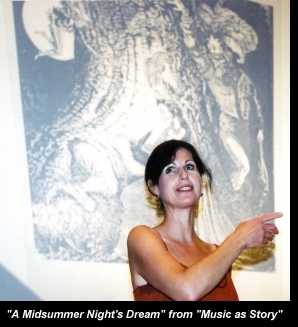
MUSIC THROUGH THE AGES
The
following use a multi-faceted approach: social context (who, when where,
why) combined with specific music.
|
Music
of the Baroque Era:
|
|
|
|
Bach: Prelude and Fugue in c minor , WTC Book 1 |
|
|
Handel: Hallelujah Chorus |
|
|
Vivaldi: The Four Seasons: Summer - Presto |
|
|
Purcell: Dido and Aeneas |
|
Music
of the Classical Era:
|
|
|
|
Haydn: The Surprise Symphony etc. |
|
|
Mozart: Symphony No. 40; The Magic Flute; sonatas, etc. |
|
|
Beethoven: All symphonies; sonatas - Tempest, Moonlight, Pathetique - etc. |
|
Music
of the Romantic Era:
|
|
|
|
Schubert: Erlkönig etc. |
|
|
Brahms: Piano Concerti No. 1 and 2; Intermezzi, Rhapsodies etc. |
|
|
Chopin, Liszt, Mendelssohn, Berlioz etc. etc. |
|
Impressionism
and Post-Impressionism:
|
|
|
|
Manet, Monet, Renoir - Debussy (assortment of works) |
|
|
Cezanne, Seurat, Mondrian - Ravel (Piano Concerto for the Left Hand, Menuet antique, Pavane pour une infante défunte, Jeux d'eau (comparison with Debussy's water music), Sonatine, Miroirs, Gaspard de la nuit, Prélude, Le Tombeau de Couperin, La Valse, Boléro) |
|
THEMATIC LECTURE/PRESENTATIONS |
|
|
A
Magical Journey to the Lands of Princes and Princesses
|
|
| Excerpts from: | |
|
|
Prince Igor (Russia): Borodin |
|
|
The Sleeping Beauty (France): Tchaikovsky |
|
|
Scheherazade (Arabia): Rimsky-Korsakov |
|
|
Turandot (China): Puccini |
|
|
Swan Lake (Germany): Tchaikovsky |
|
Music
as Story :
|
|
|
|
Beethoven: Symphony No. 5 in C minor |
|
|
Mendelssohn: Overture to A Midsummer Night's Dream |
|
|
Schubert: The Erlking |
|
|
Rimsky-Korsakov: Scheherazade |
|
|
Joplin: Maple Leaf Rag |
|
|
Prokofiev: Romeo and Juliet |
|
Piano
Through the Ages :
|
|
|
|
Baroque : Bach : Minuet in G; Invention in C; Prelude and Fugue in C minor (WTC I) |
|
|
Classical : Clementi: Sonatina, Op. 36 no. 3; Beethoven: Moonlight Sonata (3rd movement) |
|
|
Romantic : Schumann: The Happy Farmer; Chopin: The Raindrop Prelude; Liszt: La Campanella |
|
|
Twentieth Century : Debussy: La cathédrale engloutie; Ginastera: Suite des danzas criollas |
|
The
Virtuosi: The Superstars
|
|
|
|
Paganini (violinist/composer): Violin Concerti: No. 1 and No. 2 |
|
|
Liszt (pianist/composer): La Campanella, Liebesträume, Hungarian Rhapsody etc. |
|
|
Karen Kain (ballerina): Swan Lake, Giselle etc. |
|
|
Rudolph Nureyev (dancer): Don Quixote, Sleeping Beauty etc. |
|
|
Luciano Pavarotti(tenor)/Joan Sutherland (soprano) : Turandot, Lucia di Lammermoor etc. |
|
Myths,
Fables and Fantasies
(includes Program Music) (many different approaches) |
|
|
|
Dido and Aeneas: (Baroque) (myth) (Purcell) |
|
|
The Magic Flute: (Classical) (fairytale) (Mozart) |
|
|
A Midsummer Night's Dream: (early Romantic) (program music) (sonata form) (Shakespeare) (fantasy) (Mendelssohn) |
|
|
Symphonie fantastique: (early Romantic) (effect of French Revolution) (program music) (Berlioz) (the fantastic) |
|
|
Scheherazade: (late Romantic) (Russia) (fable/myth) (program music) (Rimsky-Korsakov) |
|
|
La cathédrale engloutie: (Impressionism) (Debussy) |
|
Ragtime,
Blues and Jazz: American Music
|
|
|
|
Dvorak: (use of African-American spirituals) Symphony from the New World |
|
|
Joplin: Maple Leaf Rag, The Entertainer |
|
|
Debussy: (influence of American jazz in Europe) Le Petit Négre, Golliwogg's Cakewalk |
|
|
Gershwin: Rialto Ripples, Three Preludes, Rhapsody in Blue, Summertime |
|
|
Ella Fitzgerald: Empty Bed Blues |
|
|
Louis Armstrong: West End Blues |
|
|
Copland: Rodeo |
|
Musical
Nationalism: Why Composers Write
|
|
|
|
Symphonies No. 3 and 5: (Beethoven) (French Revolution/Napoleon) (Classical) |
|
|
Revolutionary Etude: (Chopin) (Invasion of Poland by Russia) (Romantic) |
|
|
The Moldau: (Smetana) (physical beauty of one's own country) (Romantic) |
|
|
Onegin: (Tchaikovsky ballet) (Pushkin - celebration of Russian poetry) |
|
|
Finlandia: (Sibelius) (patriotism) |
|
The
Great Musicals: Great stories of literature told through great
20th c. musicals
|
|
|
|
Show Boat: (the first musical) |
|
|
West Side Story: (Shakespeare's Romeo and Juliet) (same year as My Fair Lady) |
|
|
My Fair Lady: (Shaw's Pygmalion) (same year as West Side Story) |
|
The
Music of Russia:
|
|
|
|
The Mighty Five: Mussorgsky (Pictures at an Exhibition), Borodin (Prince Igor - Polovtsian Dances), Rimsky-Korsakov (Scheherazade) |
|
|
Tchaikovsky: (Sleeping Beauty, Nutcracker, Swan Lake, Onegin, Symphonies etc.) |
|
|
Rachmaninov: (Piano Concerto No. 2, Preludes in C sharp minor and G minor) |
|
|
Prokofiev: (Romeo and Juliet) |
|
|
Stravinsky: (Firebird) |
|
Women
in Music: (composers, performers, muses, patrons)
|
|
|
|
Hildegard: Play of the Virtues |
|
|
Clara Schumann: short lyric piano pieces; Robert Schumann's Piano Concerto |
|
|
Fanny Mendelssohn: lieder |
|
|
Madame von Meck: (Tchaikovsky) |
|
Forms
in Music (presented anecdotally; history and analysis)
|
|
|
|
Fugue : Bach Prelude and Fugue in c minor (WTC I) (physical approach - clap, stand at subject entries etc.) |
|
|
Sonata/Symphonic form: Mozart, Beethoven (visual approach - what the audience can see in the music) |
|
|
Lieder: Schubert Erlkönig (story-telling through song; durchkomponiert) |
|
|
Opera
and Ballet (story-telling through words and dance)
|
